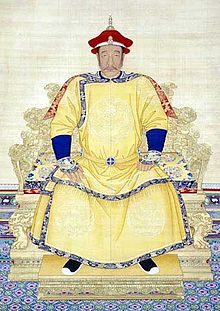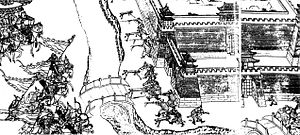- Nurhaci
-
Nurhaci Khan of the Later Jin Dynasty Reign 17 February 1616 – 30 September 1626
(10 years, 225 days)Predecessor None
(Dynasty established)Successor Hong Taiji  1st Emperor of the Qing Dynasty
1st Emperor of the Qing DynastyPredecessor None
(Awarded posthumously)Successor Hong Taiji Spouse Lady Tunggiya
Empress Xiaocigao
Empress Xiao Lie Wu
13 concubinesIssue Princess Donggo
Cuyen, Crown Prince
Daišan, Prince Li
Abai, Duke of Zhen
Tangguldai, Duke of Fu
Manggūltai
Princess Nunje
Tabai, Duke of Fu
Abatai
Mangguji, Princess Hada
Hong Taiji, Emperor Taizong of Qing
Babutai, Duke of Zhen
Degelei, Beile
Mukushen
Babuhai, Duke of Zhen
Daughter
Daughter
Daughter
Ajige, Prince Ying
Laimbu, Duke of Fu
Dorgon, Prince Rui
Daughter
Dodo, Prince Yu
FiyangguFull name Chinese: Aixin-Jueluo Nǔ'ěrhāchì 努爾哈赤
Manchu: Aisin Gioro hala-i Nurhaci ᠠᡳᠰᡳᠨ ᡤᡳᠣᡵᠣ ᠨᡠᡵᡥᠠᠴᡳ
Era name and dates Tiānmìng 天命
Manchu: Abkai fulingga: 1616 - 1626Posthumous name Chéngtiān Guǎngyùn Shèngdé Shéngōng Zhàojì Lìjí Rénxiào Ruìwǔ Duānyì Qīn'ān Hóngwén Dìngyè Gāo Huángdì
承天廣運聖德神功肇紀立極仁孝睿武端毅欽安弘文定業高皇帝
Manchu: Dergi hūwangdiHouse House of Aisin Gioro Father Taksi Mother Lady Hitara Born 21 February 1558 Died 30 September 1626 (aged 68)
Ningyuan, ManchuriaNurhaci (Manchu:
 ; simplified Chinese: 努尔哈赤; traditional Chinese: 努爾哈赤; pinyin: Nǔ'ěrhāchì; alternatively Nurhachi; 1559 – 30 September 1626) was an important Jurchen chieftain who rose to prominence in the late sixteenth century in what is today Northeastern China. Nurhaci was part of the Aisin Gioro clan, and reigned from 1616 to his death in September 1626.
; simplified Chinese: 努尔哈赤; traditional Chinese: 努爾哈赤; pinyin: Nǔ'ěrhāchì; alternatively Nurhachi; 1559 – 30 September 1626) was an important Jurchen chieftain who rose to prominence in the late sixteenth century in what is today Northeastern China. Nurhaci was part of the Aisin Gioro clan, and reigned from 1616 to his death in September 1626.Nurhaci reorganized and united various Jurchen tribes (the later "Manchu"), consolidated the Eight Banners military system, and eventually launched an assault on Ming Dynasty and Korea's Joseon Dynasty. His conquest of China's northeastern Liaoning province laid the groundwork for the conquest of the rest of China by his descendants, who would go on to found the Qing Dynasty in 1644. He is also generally credited with the creation of a written script for the Manchu language.
Contents
Name and titles
Nurhaci is written as
 in the Manchu language. Regarded as the founding father of the Qing Dynasty, he is given the customary temple name of Taizu, which is traditionally assigned to founders of dynasties. His name is also alternatively spelled Nurgaci, Nurhachi, or Nu-er-ha-chi (the last of these simply the transcription of the Chinese characters used to write his name).
in the Manchu language. Regarded as the founding father of the Qing Dynasty, he is given the customary temple name of Taizu, which is traditionally assigned to founders of dynasties. His name is also alternatively spelled Nurgaci, Nurhachi, or Nu-er-ha-chi (the last of these simply the transcription of the Chinese characters used to write his name).Nurhaci was the last chieftain of the Jianzhou Jurchens and First Khan of Later Jin Dynasty. His title in Manchu as Khan was Geren gurun-be ujire genggiyen Han
 (“Brilliant Khan Who Benefits All Nations”). His Chinese reign name was Tianming (Chinese: 天命; Manchu: ᠠᠪᡴᠠᡳ ᡶᡠᠯᡳᠩᡤᠠ Abkai fulingga), in Mongolian Tengri-yin Süldetü. He was given a posthumous name in 1736 (see infobox), the shortened form of which was "Emperor Gao" (Chinese: 高皇帝).
(“Brilliant Khan Who Benefits All Nations”). His Chinese reign name was Tianming (Chinese: 天命; Manchu: ᠠᠪᡴᠠᡳ ᡶᡠᠯᡳᠩᡤᠠ Abkai fulingga), in Mongolian Tengri-yin Süldetü. He was given a posthumous name in 1736 (see infobox), the shortened form of which was "Emperor Gao" (Chinese: 高皇帝).Life
Nurhaci was born in 1559. Being a member of the Gioro clan of the Suksuhu River tribe, Nurhaci also claimed descent from Möngke Temür, a Mongol-Jurchen headman who lived some two centuries earlier. According to Chinese sources[citation needed], the young man grew up as a soldier in the household of Ming Dynasty General Li Chengliang in Fushun, where he learned Chinese. He named his clan Aisin Gioro around 1612, when he formally ascended the throne as Khan of Later Jin.
In 1582 his father Taksi and grandfather Giocangga were killed in an attack on Gure (today a village in Xinbin Manchu Autonomous County) by a rival Jurchen chieftain Nikan Wailan ("Nikan Wailan" means "Secretary of Chinese people" in Jurchen language, thus his existence is suspected by some historians.) while being led by Li Chengliang. The following year, Nurhaci began to unify the Jurchen bands around his area.
In 1584, when he was 25, he attacked Nikan Wailan at Tulun (today a village in Xinbin too) to avenge the deaths of his father and grandfather, who are said to have left him nothing but thirteen suits of armor. Nikan Wailan fled away to Erhun, which got attacked by Nurhaci again in 1587. Nikan Wailan this time fled to Li Chengliang's territory. Later, as a way to build relationship, Li gave Nikan Wailan to Nurhaci, who beheaded Nikan Wailan immediately. With Li's support, Nurhaci gradually grew his strength in the following years.
In 1593, the nine allied tribes of Yehe, Hada, Ula, Hoifa, Khorchin, Sibe, Guwalca, Jušeri, and Neyen attacked Nurhaci but all were completely defeated at the Battle of Gure.
From 1599 to 1618, Nurhaci engaged on a campaign on conquering the four Hulun tribes. In 1599, he attacked the Hada, finally conquering the Hada in 1603. Then in 1607, with the death of its beile Baindari, Hoifa was conquered, followed by an expedition against Ula and its beile Bujantai in 1613 and finally defeating Yehe and its beile Gintaisi at the Battle of Sarhu in 1619.
In 1599, he had two of his translators, Erdeni Bagshi and Dahai Jarguchi, create the Manchu alphabet by adapting the Mongolian script.
In 1606, he was granted the title of Kundulun Khan by the Mongols.
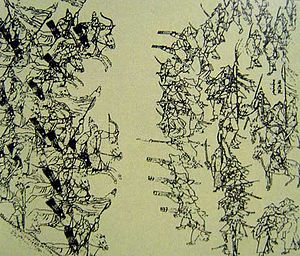 At the Battle of Sarhu Nurhaci defeated a four pronged Chinese offensive intended to capture his capital of Hetu Ala by concentrating his forces in one column at a time.
At the Battle of Sarhu Nurhaci defeated a four pronged Chinese offensive intended to capture his capital of Hetu Ala by concentrating his forces in one column at a time.
In 1616, Nurhaci declared himself Khan (King) and founded the Jin Dynasty (aisin gurun), often called the Later Jin. He constructed a palace at Mukden (present-day Shenyang) in Liaoning province. (The earlier Jin Dynasty of the twelfth century had also been formed by the Jurchen.) Jīn was renamed Qīng by his son Hong Taiji after his death in 1626, but Nurhaci is usually referred to as the founder of the Qing dynasty.
Only after he became khan did he finally unify the Ula (clan of his consort Abahai, mentioned below) and the Yehe (clan of his consort Monggo, along with the last Empress Dowager Cíxǐ, and many more consorts of Qing Emperors in between).
In 1618, Nurhaci commissioned a document entitled the Seven Grievances in which he enumerated seven grievances against the Ming and began to rebel against the domination of the Ming Dynasty. A majority of the grievances dealt with conflicts against Yehe, and Ming favouritism of Yehe.
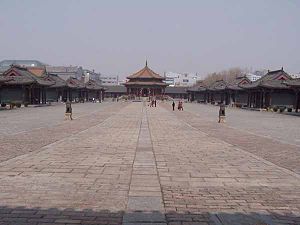 In 1625 Nurhaci started the building of a new palace for his Dynasty's capital in Mukden.
In 1625 Nurhaci started the building of a new palace for his Dynasty's capital in Mukden.
Nurhaci led many successful engagements against the Ming Dynasty, the Koreans, the Mongols, and other Jurchen clans, greatly enlarging the territory under his control. Finally in 1626 Nurhaci suffered the first serious military defeat of his life at the hands of the Ming general Yuán Chónghuàn. Nurhaci was wounded by Yuan's Portuguese cannon (紅衣大炮) in the Battle of Ningyuan. Unable to recover either physically or mentally, he died 2 days later at a little town called De-A Man (靉福陵隆恩門) on 30 September, at the age of 68. His tomb (Chinese: 福陵; pinyin: Fúlíng) is located east of Shenyang.
Among the most lasting contributions Nurhaci left his descendants was the establishment of the so-called Eight Banners, which would eventually form the backbone of the military that dominated the Qing empire. The status of Banners did not change much over the course of Nurhaci's lifetime, nor in subsequent reigns, remaining mostly under the control of the royal family. The two elite Yellow Banners were consistently under Nurhaci's control. The two Blue Banners were controlled by Nurhaci's brother Šurhaci until he died, at which point the Blue Banners were given to Šurhaci's two sons-Chiurhala and Amin. Nurhaci's eldest son-Cuyen- controlled the White Banner for most of his father's reign - until he rebelled. Then the Bordered White Banner was given to Nurhaci's grandson and the Plain White was given to his eighth son and heir, Hong Taiji. However, by the end of Nurhaci's reign, Hong Taiji controlled both White Banners. Finally, the Red Banner was run by Nurhaci's second son Daishan. Later in Nurhaci's reign, the Bordered Red Banner was handed down to his son. Daishan and his son would continue holding the two Red Banners well into the end of Hong Taiji's reign.
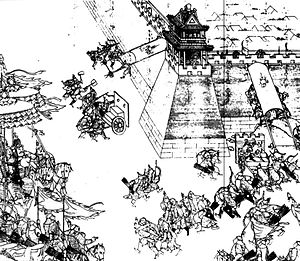 Nurhaci watching his army storm the walls of Ningyuan, 1626.
Nurhaci watching his army storm the walls of Ningyuan, 1626.
As noted, Nurhaci was succeeded by his eighth son, Hong Taiji. It is said Hong Taiji took the throne by coercing his father's third consort Abahai to commit suicide, in order to block the succession of his younger brother Dorgon. The reason such intrigue was necessary is that Nurhaci had left the two elite Yellow Banners to Dorgun and Dodo, who were the sons of Abahai. Hong Taiji exchanged control of his two White Banners for that of the two Yellow Banners, shifting their influence and power from his young brothers onto himself. At the same time, by forcing Abahai to follow her husband into death, he assured that there would be no one to support the 15-year-old Dorgon or 14-year-old Dodo.
Family
Ancestors
- Great-Great-Grandfather
- Möngke Temür (1370–1433), personal name Mengtemu (孟特穆), posthumously honored as Emperor Yuan (原皇帝, Da Hūwangdi) with the temple name of Zhaozu (肇祖, Deribuhe Mafa)
- Great-Great-Grandmother or step-great-great-grandmother
- Mengtemu's wife, posthumously honored as Empress Yuan (原皇后)
- Great-Grandfather
- Fuman, posthumously honored as Emperor Zhi (直皇帝, Tondo Hūwangdi) with the temple name of Xingzu (興祖, Yendibuhe Mafa)
- Great-grandmother or step-great-grandmother
- Lady Hitara (喜塔拉氏), Fuman's wife, daughter of Captain Doulijin (都督 都理金), posthumously honored as Empress Zhi (直皇后)
- Grandfather
- Giocangga (died 1583), posthumously honored as Emperor Yi (翼皇帝, Gosingga Hūwangdi) with the temple name of Jingzu (景祖, Mukdembuhe Mafa)
- Grandmother or step-grandmother
- Giocangga's wife, posthumously honored as Empress Yi (翼皇后)
- Father
- Taksi (died 1583), posthumously honored as Emperor Xuan (宣皇帝, Hafumbuha Hūwangdi) with the temple name of Xianzu (顯祖, Iletuleha Mafa)
- Mother
- Lady Hitara (喜塔拉氏) (died 1569), Taksi's wife, daughter of Captain Agu (都督 阿古), granddaughter of Captain Cancha (都督 參察), great-granddaughter of Captain Doulijin (都督 都里吉), posthumously honored as Empress Xuan (宣皇后)
Siblings
- Brothers (same mother)
- Šurhaci (舒爾哈齊) (1564–1611)
- Yarhaci (雅爾哈齊)
- Sister (same mother)
- Lady Aisin Gioro (愛新覺羅氏), married Gehashan Hasihu (噶哈善哈斯虎)
- Half-Brothers
- Bayara (巴雅齊)
- Murhaci (穆爾哈齊) (1582–1624)
Consorts
Nurhaci had a total of 16 consorts:
- Lady Tunggiya (佟佳氏), given name Hahana Jacing (哈哈納扎青), daughter of Tabonbayan (塔木巴晏). She married Nurhaci in 1577 as his first wife and initial consort. After the founding of the Qing Dynasty, she was posthumously honored as First Consort (元妃; Yuan Fei). Lady Tunggiya bore Nurhaci three children:
- Princess Dongguo
- Cuyen, Crown Prince
- Daišan, Prince Li
- Lady Fuca (富察氏), given name Gundai (袞代). She was Nurhaci's second consort. After the founding of the Qing Dynasty, she was posthumously honored as Successor Consort (繼妃; Ji Fei). Lady Fuca bore Nurhaci three children:
- Manggūltai
- Mangguji, Princess Hada
- Degelei, Beile
- Lady Yehenara (葉赫那拉氏) (given name Monggo Jer-Jer (孟古哲哲)) (1575–1603), daughter of Prince Yangginu of the Yehenara (葉赫部貝勒楊吉砮). She married Nurhaci in October 1588 at the age of 13. On 16 May 1636, she was posthumously honored as Empress Xiaocigao (孝慈高皇后). Lady Yehenara bore Nurhaci one child:
- Lady Ulanara (烏喇那拉氏) (given name Abahai (阿巴亥)) (1590–1626), daughter of Prince Mantai of the Ulanara (烏拉貝勒滿泰) (died 1596). She married Nurhaci in 1602 at the age of 12. In 1603 she was created Grand Consort (大妃). She was posthumously honored as Empress Xiao Lie Wu (孝烈武皇后). Lady Ulanara bore Nurhaci three children:
- Lady Borjigit (博爾濟吉特氏), posthumously honored as Dowager Consort Shou Kang (壽康太妃).
Four of Nurhaci's consorts held the rank of Side Chamber Consort (側妃; Ze Fei):
- Lady Irgen Gioro (伊爾根覺羅氏), bore Nurhaci two children:
- Princess Nunje
- Abatai
- Lady Yehenara (葉赫那拉氏), younger sister of Empress Xiaocigao. She bore Nurhaci one child:
- Nurhaci's eighth daughter
- two unnamed consorts
Five of Nurhaci's consorts held the rank of Ordinary Consort (庶妃; Shu Fei):
- Lady Joogiya (兆佳氏), bore Nurhaci one child:
- Abai, Duke of Zhen
- Lady Niuhuru (鈕祜祿氏), bore Nurhaci two children:
- Tangguldai, Duke of Fu
- Tabai, Duke of Fu
- Lady Giyamuhut Gioro (嘉穆瑚覺羅氏) (given name Zhen'ge (真哥)), bore Nurhaci five children:
- Babutai, Duke of Zhen
- Mukushen
- Babuhai
- Nurhaci's fifth daughter
- Nurhaci's sixth daughter
- Lady Silin Gioro (西林覺羅), bore Nurhaci one child:
- Lady Irgen Gioro (伊爾根覺羅氏), bore Nurhaci one child:
- Nurhaci's seventh daughter
Sons
- Eldest son: Cuyen (褚英) (1580–1618), Nurhaci's initial Crown Prince, posthumously honored as Crown Prince Guang'e (廣略太子)
- 2nd: Daišan (代善) (19 August 1583 - 25 November 1648), created Prince Li of the First Rank (禮親王), granted the posthumous name Lie (烈)
- 3rd: Abai (8 September 1585 - 14 March 1648), created General of Zhen (鎮國將軍), posthumously honored as Duke of Zhen (鎮國公) with the posthumous name Qinmin (勤敏), had 7 sons
- 4th: Tangguldai (湯古代) (24 December 1585 - 3 November 1640), created General of Zhen (鎮國將軍), posthumously honored by the Shunzhi Emperor as Duke of Fu (輔國公) with the posthumous name Kejie (克潔), had 2 sons
- 5th: Manggūltai (莽古爾泰) (1587 - 11 January 1633)
- 6th: Tabai (塔拜) (2 April 1589 - 6 September 1639), created General of Fu (輔國將軍), posthumously honored as Duke of Fu (輔國公) with the posthumous name Quehou (慤厚), had eight sons
- 7th: Abatai (阿巴泰) (27 July 1589 - 10 May 1646)
- 8th: Hong Taiji (皇太極) (28 November 1592 - 21 September 1643), succeeded Nurhaci as Emperor of the Qing Dynasty
- 9th: Babutai (巴布泰) (13 December 1592 - 27 February 1655), created Duke of Zhen (鎮國公), granted the posthumous name Kexi (恪僖), had 3 sons
- 10th: Degelei (德格類) (16 December 1592 - 11 November 1635), held the rank of Beile, had 3 sons
- 11th: Babuhai (巴布海) (15 January 1597 - 1643)
- 12th: Ajige (阿濟格) (28 August 1605 - 28 November 1651)
- 13th: Laimbu (賴慕布) (26 January 1612 - 23 June 1646), posthumously honored as Duke of Fu (輔國公) with the posthumous name Jiezhi (介直)
- 14th: Dorgon (多爾袞) (17 November 1612 - 31 December 1650), created Prince Rui of the First Rank (睿親王), granted the posthumous name Zhong (忠), posthumously honored as an Emperor of the Qing Dynasty with the temple name of Chengzong (成宗) by the Shunzhi Emperor
- 15th: Dodo (多鐸) (2 April 1614 - 29 April 1649), created Prince Yu of the First Rank (豫親王) with the posthumous name Tong (通)
- 16th: Fiyanggu (費揚果) (November 1620 - ?), had four sons
Daughters
- Eldest daughter: Princess Donggo (東果格格) (1578 - August/early September 1652), married in 1588 Hohori (何和禮) (1561–1624), held the rank of State Princess (固倫公主)
- 2nd: Princess Nunje (嫩哲格格) (1587 - late August/early September 1646), married Darkhan (達爾漢), held the rank of Princess of the Second Rank (和碩公主)
- 3rd: Mangguji (莽古濟) (1590–1635), married firstly in 1601 Hadanara Worgudai (哈達部納喇.吳爾古代) (son of Menggebulu (孟格布祿)) and had two daughters, married secondly in 1627 Borjigit Suonuo Muduling (博爾濟吉特.瑣諾木杜凌), held the title of Princess Hada (哈達公主)
- 4th: Mukushen (穆庫什) (1595 - ?); married in 1608 Prince Bujantai of the Ulanara (烏拉國主布佔泰), last prince of the Ula
- 5th: Princess ? (1597–1613); married in 1608 Niohuru Daqi (鈕祜祿.達啟), son of Niohuru Eyidou (鈕祜祿.額亦都)
- 6th: Princess ? (1600 - October/early November 1646), married in 1613 Yehenara Suna (葉赫那拉.蘇納) (father of Suksaha)
- 7th: Princess ? (April 1604 - August 1685), married in November or early December 1619 Nara Ezhayi (納喇.鄂札伊) (died May/early June 1641)
- 8th: Princess ? (1612 - March/April 1646), married in February or early March 1625 Borjigit Gorbushi (博尔济吉特.固尔布什), held the rank of Princess of the Second Rank (和碩公主)
Ancestry
Ancestors of Nurhaci 16. Mengtemu 8. Fuman 4. Giocangga 18. (=24.)Captain Doulijin 9. Lady Hitara 2. Taksi 1. Nurhaci 24. (=18.)Captain Doulijin 12. Captain Cancha 6. Captain Agu 3. Lady Hitara Primary sources
Information concerning Nurhaci can be found in later, propagandistic works such as the Manchu Veritable Records (in Chinese Mǎnzhōu Shílù 滿洲實錄, in Manchu the Yargiyan kooli.) Good contemporary sources are also available. For instance, much material concerning Nurhaci's rise is preserved within Korean sources such as the Annals of the Joseon Dynasty (Joseon Wangjo Sillok朝鮮王朝實錄), especially the Seonjo Sillok and the Gwanghaegun Ilgi. Indeed, the record of Sin Chung-il's trip to Jianzhou is preserved in the Seonjo Sillok.
The original Manchu language records from Nurhaci's reign also survive. A revised transcription of these records (with the dots and circles added to the script) was commissioned by the Qianlong emperor. This has been translated into Japanese, under the title Manbun roto, and Chinese, under the title Manwen Laodang (Chinese:满文老襠). A project is currently under way at Harvard to translate them into English, as The Old Manchu Chronicles.[1]
Popular culture
The remains of Nurhaci are used as a plot device in the beginning of the 1984 movie Indiana Jones and the Temple of Doom.
See also
- Fuling Tomb
- Li Chengliang - Military general of the Ming Dynasty in charge of the Jurchen tribes
Notes
NurhaciHouse of Aisin-GioroBorn: 1558 Died: 30 September 1626Regnal titles Preceded by
TaksiChieftain of the Jianzhou Jurchens
1583-1616Succeeded by
Hong TaijiPreceded by
none
(Dynasty established)Khan of Later Jin
1616-1626Categories:- 1558 births
- 1626 deaths
- Inventors of writing systems
- Manchu people
- Qing Dynasty emperors
- 17th-century Chinese monarchs
- Great-Great-Grandfather
Wikimedia Foundation. 2010.

